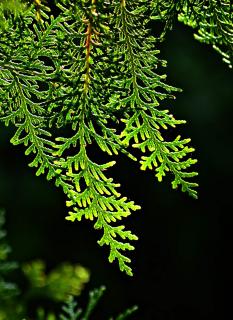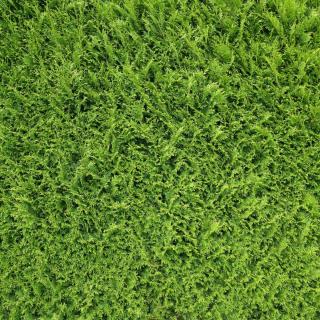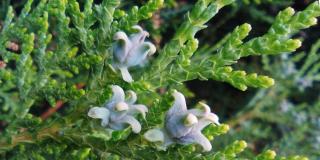

Thuja isn’t the most elegant conifer but it does truly excel in cutting off the view for intrusive onlookers.
Key facts about thuja
Name – Thuja
Often misspelled as – Thuya
Family – Cupressaceae
Type – conifer, evergreen hedge
Height – up to 65 feet (20 meters)
Exposure – full sun to shade
Soil – ordinary, well drained – Foliage – evergreen
Thuja isn’t a hedge shrub that is particularly supportive of biodiversity. Nonetheless, it’s a very fast grower and forms a thick, opaque screen. This makes it one of the most commonly used species to set up hedges.

When purchased in containers, a thuja can be planted in the ground almost all year round, except when it freezes.
After planting, you can also mulch the foot of the tree in order to avoid having weeds crowd it out from below but also to protect the roots from the cold.

For hedges, select the pruning height you are comfortable with as well as the thickness.
A heavy pruning end of August is enough to keep this growth under control.
That is also the season where sap descends and so it will slow the thuja’s growth a bit.
Spring pruning is usually with rising sap and tends to accelerate the tree’s growth, so this is ideal if you aim to hide yourself from prying neighbor’s view.
Sometimes you might end up in a place where a runaway thuja is gobbling up too much space in the garden. Follow these tips to cut a large thuja back.
Thuja is very disease-resistant and resists fungus, too.
The thuja tree is native to North America, where it’s commonly called Arborvitae, which means “tree of life” in Latin. This name was given it for its evergreen foliage that stays put from January to December.
It’s also reputed to be an excellent wind-breaker, ready to resist gales of any power – and block out inquisitive neighbors, too; this particular trait is what makes it an extremely common choice for setting a hedge up.

From an aesthetic point of view, it doesn’t have any other advantage than the deep green that lasts all year round and a high opaqueness.
Also, know that if the climate is hot in summer, thuja might not be your best candidate because it requires water.
When part of a hedge, think well about how high you want it to grow so that you can determine the planting distance of your thuja accordingly! Keep a spacing of about 32 inches (80 cm) to 3 feet (1 meter) for the usual 6-foot (1.80 m) hedge.
Hi Michael
I’d love to hear how this turned out for you. I am having the same issues myself with a large 30 metre long hedge of thujas that sit on my side of a boundary line. I’m only in this property 6 months, so unfortunately inherited these hedge problems! They are planted a metre apart, are now 8 metres tall with a 4-5 metre spread, with more of the spread being on my side, which is also the sunnier side. There is a terrible amount of deadzone in places. I would love to take the hedge back in a metre or more on my side. But not sure about sever pruning like that on my side would allow regrowth to occur and to be better managed
Hi Owen, we got together with Michel and wrote up an article describing the outcome. It really looks nice, and a year after cutting the thuja short, it’s already nice and lush again!
Hi, I planted a thuja smaragd hedge at the beginning of May 2021, some thujas have red-brown leaves (just part of the leaves) and three thujas (almost the whole tree) turn to red-brown. I use a dripping hose to water all the thujas, so I don’t know why some are doing good, and some are turning brown. I don’t know if I didn’t water them enough or overwatered them. Do you have any suggestions on what should I do to help the thujas, I hope they can survive. Thanks a lot!
Hi Amy, red-brown leaves aren’t a very good sign, and if three of the trees are dying off something is definitely wrong. There are a few possibilities:
– if you’re in a place that gets very cold, it might be due to winter burn. This happens if it freezes deeply. Usually only the outer portions of the tree are affected, and in this case it’s more or less evenly spread around the tree, never only striking a single branch. If there was a strong freezing after you planted them, this might be what happened. Not much to do but wait it out, new growth will come back.
– if you’ve overwatered, it might be suffocating underground if drainage isn’t good. Is the soil soggy underneath the trees? Or still very dry? If it’s too soggy, fungus will develop underground and sap can’t circulate to the branches. In this case, the whole tree tends to lose its stark green color and becomes yellowish and even grayish as it struggles. Branches droop loosely over. If this is the case, stop watering entirely and only resume, with much less water, after three full weeks.
– if you’ve underwatered (soil that is dust dry at the depth of a finger), then symptoms are somewhat droopy as well, but only the tips of the branches react at first, losing their color and turning yellow more or less across the whole tree.
– a more terrible possibility is that of fire blight. This is a disease that may have been dormant in the ground, or brought along from the nursery. Check with the nursery if they have other infected trees from the same batch, it might help improve the quality of their products and services. If not, then read up on how to deal with fire blight on Thuja trees.
– lastly, the last possibility is simply a form of transplant shock. Spring, while not a bad season to plant shrubs, isn’t as good a planting time as Autumn. This is because plants need roots at full capacity to grow, but due to repotting and transplanting, roots haven’t made their way to the surrounding soil. There’s a whole collection of articles on transplant shock here, but the one that might be most relevant in your case is this one about helping a tree survive transplant shock.
Hi Gaspard, thank you very much for all your advice. I just checked these three Thujas again, the topsoil is dust-dry, I put my finger into the soil, it’s still a little moist and it’s not soggy. Lately, I run the dripping hose every night for about 3 hours (it’s about 3 gallons (10L) of water per thuja), it’s pretty hot in the daytime (the temperature is over 86F(30C) ). I checked the leaves, it’s still green inside, and outside leaves are reddish yellow( actually these three Thujas are not reddish-brown colour) and most of the leaves are curly, some are already cripy, and branches droop. Should I give extra water for these three thujas?
I checked other Thujas have reddish-brown leaves, just part of the branches are reddish-brown, most of the leaves are still green and healthy, it seems like transplant shock, I will check the articles about that. Hopefully, they can survive.
Thanks a lot!
Don’t be sorry, I was very impressed with the amount of info you put up there. I think people in general do like very detailed ways of doing things when they don’t know much about something.
Best Regards MM
Hello, I live in Sydney (Aus.) area and I have 6 Thujas with the largest 4m high by 2m wide in an area 7m10m. They are beautiful but getting a little out of hand!
I wanted to prune/reduce them. I almost be happy to have them 50% less… But 3/4 would be ok too. When ever I took a little of the width (some time on one side only) It took ages to re cover the pruned area.
I understand that spring is a good time to do it for active regrowth. But I has not be that good for me and I don’t get much of ‘green’ back for a long time?
Now if i reduce them by 25% or more will loose their conic shape for ever, or I can reshape them a little ? If it’s ok I’d like to do it in a couple of months which will be end of summer beginning of spring. Thank you for your article and your time MM:)
PS: not much of a FB fan although occasionally use it…
Hi Michel, that’s a case of runaway thuja! It’s a hard shrub to get back under control, but not impossible. As you noted, theoretically it can (and often does) grow back from the trunk. However, it takes time and depends on other factors such as planting density/competition, light, soil nutrition, watering in summer, etc. In my area, a neighbor trimmed one side of his hedge to the trunk due to a city ordnance, and it’s only starting to fill in after 3 full years, next year only will it be fine.
I would do the following in your case:
– on the Northern sunny side, get a feeling of how deep the green leafage goes, for instance it might be 20 or 30 cm deep (about a foot).
– cut and trim these in such a way as to leave one-third of the greenery on the tree.
– on the South-facing shaded sides, leave about half of the greenery on the tree.
That way, you’ll have reduced the width by more than the year’s growth without leaving the tree bare. It won’t be a 50% result though, more like 20% smaller only.
In the following year, you can do the same: get a feeling of how deep the greenery goes, and trim back 2/3rds on the sunny side, half on the shaded side.
If you want to be able to cut more back every year, you’ll have to spend time creating a “checkered pattern”. The goal is, after pruning, to create opening for light to enter, as regularly as can be. For instance, you’d reach in and snip a branch off to create a hole as big as a hand, then do it again at a hand’s distance, and so on. That way, buds will sprout deeper in the tree, and you can cut back more in the following year. But it’s a whole lot of work! You can make larger checkers to go faster/further in, but then it gets more noticeable.
Lopping of the top shouldn’t make you feel scared, since the dense growth will cover the tip up. What you can do is try to see where the pruning leads to, and then cut the top off slightly below that point. It’ll make a “plateau” about 30-50 cm across (1 to 2 feet). It’ll make the tree look a bit like a cone with a cut top after your efforts, but the advantage is that it lets light enter to the center of the tree, triggering growth there. Since you’ll keep reducing the tree and topgrowth will resume, that conical look will be back within the year.
All that should still produce nice enough trees while gradually reducing size.
The other alternative to go “faster” leads to gangly, knobby trees for up to 5 years, but at least you get the size goals immediately:
– year 1: on the sunny side, cut back almost to the trunk, leaving 10 or 15 cm stubs (half a foot). Lop the top off to the desired height. Don’t touch the shaded side.
– year 2: sunny side, snip new growth back in spring to trigger branching out. If growth on the sunny side has started (5-10 cm sprigs or 2-4 inches), at the same time, hard prune the shaded side as you had the sunny side. If not, only prune the shaded side in year 3. After that, prune regularly and often to shape the trees.
Whatever you do, make sure to keep the soil moist and full of nutrients with weed tea!
PS: welcome! Also not a fan of FB, but some swell people are on it and it helps spread the message… We have lots of other social media networks, too: twitter, pinterest, mewe, mastodon, youtube, instagram…
Hello Gaspard, and thank you for a very comprehensive and interesting reply.
It is perhaps a little above my ‘gardner’s ‘ comprehension although I think I got it.
You seem to indicate that if I was going to chop it in half eventually it is quite likely it will regrow but may look a little unsightly for a few years. Did i get this right ?
As for a better job I understand that on the sunny side I may take a little more (like half of what is green) But in practice I thought there is little to take before getting behind the green! Anyway and on the shady side to take even less.
As for the chekered prunning that sounds like a good idea and I understand the more i’ll take on one spot the worse it’ll look (a little like pixel on a picture. the more little green spot I can leave behind all over the place the better it’ll look.
As for the “Crown” I think I get this too. The lower branches will kind of cup it for a while till regrowth fill it again. Although in practice I may have a little shock!
My wife pointed out to me that Spring does not follow Summer! Yep sometimes the mind is busy and does not write what one knows quite well. But all this work should be done late Summer beginning of Autumn doesn’t it?
I really like them to be smaller and patience is not one of my virtues …But I’ll hate to be sorry for cutting them to short although we are the only one who can see them behind the house….
Thank you again 🙂
Sorry for my long-ish answer, I got a bit carried away… but you got the gist of it! Yes, you can go ahead and savor your full lush trees all Summer long, and then start chopping away at them in Fall. Take a few pictures for remembrance!